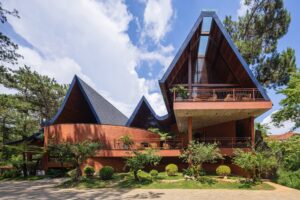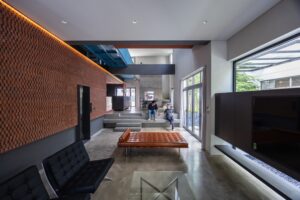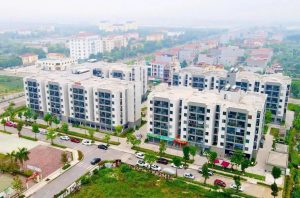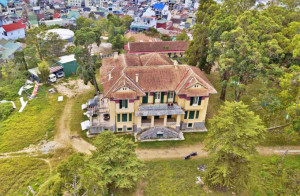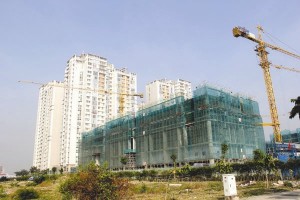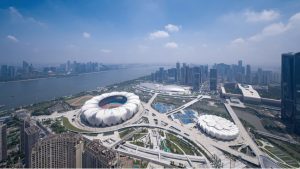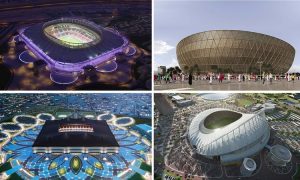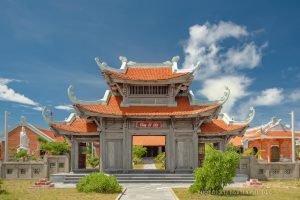Công bố quốc tế trong lĩnh vực kiến trúc, xây dựng (Tuần 1 tháng 5-2021)
Trong số này chúng tôi xin giới thiệu tới quý độc giả những nội dung chính của các công bố quốc tế đăng tải trên ScienceDirect và Springer Nature do Cục Thông tin khoa học và công nghệ quốc gia (NASAT) mua quyền truy cập như sau:
Quy hoạch đô thị:
– Đánh giá sự đóng góp của không gian xanh đô thị trong quy hoạch chiến lược hạ tầng xanh đối với các điều kiện và dịch vụ hệ sinh thái đô thị
– Xây dựng đa dạng sinh học vào cấu trúc đô thị: Nghiên cứu điển hình về áp dụng Thiết kế đô thị nhạy cảm với đa dạng sinh học (BSUD)
– Những tác động lâu dài của sự thâm nhập của xe điện trong các kịch bản khử cacbon ở đô thị: Mô hình sử dụng đất – giao thông – năng lượng tích hợp
Khoa học và công nghệ trong lĩnh vực kiến trúc, xây dựng:
– Phát hiện vết xước bề mặt trên các tấm kính kiến trúc dựa trên hình ảnh bằng cách sử dụng phương pháp học sâu
– Thay thế thạch anh và đất sét bằng tro bay trong sản xuất gốm sứ kiến trúc
– Ảnh hưởng của kích thước và trạng thái ứng suất đến cường độ của kính kiến trúc: So sánh thực nghiệm và lý thuyết
– Đánh giá chất lượng môi trường trong nhà và mức tiêu thụ năng lượng theo thời gian thực
– Nền kinh tế tuần hoàn và nền kinh tế tuyến tính của vật liệu xây dựng: Nghiên cứu điển hình cho ván dăm làm bằng gỗ tái chế và chất tạo màng sinh học so với ván dăm thông thường
Vật liệu xây dựng:
– Mô hình động lực học hệ thống cho dòng vật liệu xây dựng của các công trình dân cư đô thị
– Tăng cường độ dẫn nhiệt bằng graphene làm phụ gia trong vật liệu biến đổi pha hỗn hợp diatomite axit lauric-stearic/đã xử lý để lưu trữ nhiệt trong lớp bọc tòa nhà
– Gỗ trong suốt với khả năng lưu trữ nhiệt biến đổi pha làm vật liệu tổng hợp lưu trữ năng lượng xanh mới để bảo tồn năng lượng xây dựng
Xin trân trọng giới thiệu!
KHOA HỌC VÀ CÔNG NGHỆ TRONG LĨNH VỰC XÂY DỰNG
1. Image-based surface scratch detection on architectural glass panels using deep learning approach
Construction and Building Materials, Volume 282, 3 May 2021, 122717
Abstract
As a transparent and traditional building material, glass products such as glass façade are vital components of buildings. However, the surface scratches generated in the manufacturing process or emerging in the service stage such as windborne debris impacts may lead to remarkable strength degradation of glass material. In order to assess the fracture possibility of glass components, the size and number of scratches should be monitored during their lifecycle. Automatic scratch detection of architectural glass therefore remains a necessary task for civil engineers. A pixel-level instance segmentation model using Mask and region-based convolutional neural network (Mask R-CNN) was proposed for scratches detection on transparent glass surface. Images with scratches were firstly collected by a tailor-made automated microscopic camera scanning system to build the training and validation dataset. Test results demonstrate that the trained network is satisfactory, achieving a mean average precision of 96.5% with low missing and false rate under background interference. A comparison between the proposed model and another segmentation method YOLACT indicates that the proposed model has better performance in both detection and segmentation accuracy. The proposed deep learning-based approach can better support the development of non-contact defect assessment techniques for transparent building materials such as glass.
2. Substitution of quartz and clay with fly ash in the production of architectural ceramics: A mechanistic study
Ceramics International, Volume 47, Issue 9, 1 May 2021, Pages 12514-12525
Abstract:
Quartz and clay are substituted gradually by fly ash using a triaxial ceramic formulation under simulated industrial conditions and the effects of fly ash substitution on the macroscopic properties and microstructures of the sintered ceramics are evaluated systematically. With the substitution of 35 wt% (1250 °C), the ceramic sample exhibited optimal properties, including linear shrinkage of 15.61%, bulk density of 2.39 g cm-3, water absorption of 0.62% and flexural strength of 41.70 MPa, due to the accelerated densification and fly ash-spurred needle-shaped mullite. The microstructure analysis shows that the sintered matrix consists of three types of particles, quartz-, clay- and feldspar-like particles showing sintering behavior with respect to filling the glassy matrix with preserved morphology, precipitating mullite crystals, and fusing with the surrounding glassy matrix, respectively. The strength of the fly ash – containing ceramics is analyzed by the dispersion-strengthening mechanism and porosity and the results indicate that the fly ash particles affect the mechanical strength due to Griffith flaws when the total porosity is less than 25% and pores at higher total porosity. This study provides a viable strategy to recycle industrial fly ash in the production of architectural ceramics.
3. The effect of size and stress state on the strength of architectural glass. Experiments versus theory
Construction and Building Materials, Volume 283, 10 May 2021, 122635
Abstract:
The multi-scale approach in the statistical evaluation of the macroscopic strength of annealed glass for architectural applications indicates a close correlation with the population of surface microcracks present in the glass sheets. The theory predicts a dependence of the strength capacity on the size of the glass element and on the state of stress acting on it. To investigate this effect, an experimental campaign has been conducted on samples of three different sizes, tested in a ring-on-ring apparatus. Data were re-normalized according to statistics of the Weibull type and re-scaled to account for the phenomenon of static fatigue. For small- and medium-size specimens, the results are in agreement with the prediction of Weibull statistical theory, according to which the larger the specimen, the greater the probability of finding cracks of critical size and, consequently, the lower the macroscopic strength on a statistical basis. On the other hand, quite surprisingly, large samples show an opposite trend. Since the state of stress is not uniform and equibiaxial in the large specimens, on the contrary to what happens in the small and medium size ones, this finding suggest a revision of classical approach based on linear elastic fracture mechanics and its correlation with the weakest-link-in-the-chain rationale in the evaluation of the mechanical properties of brittle materials such as glass.
4. On the applicability of meta-analysis to evaluate airtightness performance of building components
Building and Environment, Volume 194, May 2021, 107684
Abstract:
The scientific literature lacks comprehensive and updated information regarding the airtightness of building components, this hindering the development and improvement of models for a robust prediction of their performance. To fill this gap, this paper presents a meta-analysis conducted on literature studies reporting laboratory and in-situ measurements of airtightness for various building components. Meta-analysis is a powerful methodological tool to compare and combine data from previous research, even when they have inherent differences. The results of the meta-analysis allowed to attain three outcomes: a classification of building components related to their airtightness performance; the update and improvement of existing databases of building component airtightness; and, the identification of factors specifically influencing airtightness performances of windows. In addition, the critical appraisal of the findings led to the definition of the requirements for future studies reporting measurements of airtightness of building components. This study offers a step ahead from existing knowledge by improving existing databases and by proposing a methodological framework of analysis that can be extended to several other domains of the built environment.
5. Resilient cooling of buildings to protect against heat waves and power outages: Key concepts and definition
Energy and Buildings, Volume 239, 15 May 2021, 110869
Abstract:
The concept of climate resilience has gained extensive international attention during the last few years and is now seen as the future target for building cooling design. However, before being fully implemented in building design, the concept requires a clear and consistent definition and a commonly agreed framework of key concepts. The most critical issues that should be given special attention before developing a new definition for resilient cooling of buildings are (1) the disruptions or the associated climatic shocks to protect against, (2) the scale of the built domain, (3) the timeline of resilience, (4) the events of disruption, (5) the stages of resilience, (6) the indoor climate limits and critical comfort conditions, and (7) the influencing factors of resilient cooling of buildings. This paper focuses on a scoping review of the most of the existing resilience definitions and the various approaches, found in 90 documents, towards possible resilient buildings. In conclusion, the paper suggests a definition and a set of criteria —vulnerability, resistance, robustness, and recoverability— that can help to develop intrinsic performance-driven indicators and functions of passive and active cooling solutions in buildings against two disruptors of indoor thermal environmental quality—heat waves and power outages.
6. Structural equation model for assessing factors affecting building maintenance success
Journal of Building Engineering, Available online 7 May 2021, 102680
Abstract:
Currently, significant and continuous attention is given by governments, policymakers, local authorities, users and researchers to the ambiguous standing behind the low performance of implemented maintenance in buildings. In an attempt to understand this problem, a hypothetical structural model was developed to evaluate the factors affecting building maintenance success. By employing a structural equation modelling technique, the model adapts a total of 34 attributes across six confirmatory factors, namely, organisational-related factor (ORF), human resources-related factor (HRRF), technical-related factor (TRF), financial-related factor (FRF), building user-related factor (BURF) and overall building maintenance success (OBMS). Based on the survey data collected from a case study in Malaysia, the model results assessed the impacts of the factors above on the OBMS. With a clear understanding of the significance of these factors in the context of maintenance success, these outcomes could help develop the procedures of the maintenance organisation to enhance existing building maintenance practices towards their successful implementation. The theoretical and practical contributions, the limitations of the present study and the future paths for research have been addressed.
7. Seismic vulnerability assessment of existing school buildings
Computers & Structures, Volume 248, May 2021, 106522
Abstract:
This paper presents a methodology to perform the seismic vulnerability assessment of existing buildings. It starts with the acquisition of structural data from available construction drawings and field investigations to create a preliminary finite element model. Then, a wireless sensor network is used to collect the structural response at different locations. The sensors are connected and synchronized to each other to download and process data in real time. Modal identification methods, such as output-only and forced vibration techniques, are used to determine the modal characteristics and consequently calibrate the structural model for the subsequent vulnerability assessment. The proposed methodology is applied to a reinforced concrete school building in Italy. The seismic vulnerability is evaluated using a variety of alternative formulations. In particular, material nonlinearities and contact interaction at the structural joints are considered.
8. Indoor environmental quality and energy consumption real-time assessment: A field measurement of a nearly zero-energy building in cold region of China
Energy and Buildings, Available online 11 May 2021, 111093
Abstract:
The paper presents a two-year field measurement and assessment of a nearly zero-energy Building in cold zones of China. These parameters of indoor environment quality (IEQ) and electricity consumption for HVAC are recorded. According to the measurement data, the most of indoor temperature was controlled in the range of 23°C ~ 26°C and relative humidity (RH) mainly fluctuates within the range of 30%~ 60%. The concentrations of carbon dioxide (CO2) and particulate matter (PM2.5) are lower than the relevant standard requirements in most of the time. The average electricity consumption for HVAC was 33.05kWh/(m2·a) and the heating and cooling demands could be reduced by 55.2% and 54.0%, respectively, compared with existing buildings. In general, the NZEB can provide indoor comfortable thermal environment and indoor air quality with less energy demand, but the overheating problem in summer and effect of occupant behavior should be especially paid attention during operation. Overall, the experience from the actual operation of NZEBs will help China to reach its goals of reducing carbon emissions and addressing climate change through realizing the energy-saving potential of NZEBs.
9. Engineered bi-material lattices with thermo-mechanical programmability
Composite Structures, Volume 263, 1 May 2021, 113705
Abstract:
Lightweight meta-structures can reveal combinations of properties that do not occur in conventional structures. In this paper, a 2D bi-material unit cell is proposed based on a re-entrant architecture. Two 3D unit cells, so-called star and cubic architectures, are then constructed using the proposed 2D unit cell. Finally, lattice-based unit cells are periodically arranged to develop a meta-structure. The thermo-mechanical functionalities of the developed meta-lattices can be programmed by tailoring either architectural parameters (i.e., strut length, diameter, shape, and orientation) or the material combination of struts. The influence of the architectural parameters and material combinations on the effective elastic stiffness, Poisson’s ratio (PR), and coefficient of thermal expansion (CTE) is systematically investigated. A finite element (FE) model is established to perform a goal-driven multi-objective optimization and to attain an uncommon combination of PR and CTE (e.g. negative PR up to −1.8 or near-zero CTE) with uncompromised stiffness. Despite the complicated design (many struts are diagonal with respect to the printing bed), the low-cost additive manufacturing process (i.e., fused filament fabrication) parameters are optimized to fabricate a selected number of bi-material meta-lattices with a reasonable time and quality. By employing the FE model, the optimized architectural parameters are determined for a series of applied engineering applications such as structurally robust aerospace structures, energy absorbable structural elements, and shape transforming structures. The developed lightweight meta-lattices with tunable thermo-mechanical properties can offer the material selection charts with more economical material options for engineering applications such as antennas and precision instruments.
10. Generation of Hospital Emergency Department Layouts Based on Generative Adversarial Networks
Journal of Building Engineering, Available online 1 May 2021, 102539
Abstract:
Based on generative adversarial networks (GANs), a type of deep learning model, this paper takes the functional layout of the emergency departments (EDs) of general hospitals as the research object, combines the hierarchical design concepts and proposes an intelligent functional layout generation method for EDs. It aims to explore the application of intelligent algorithms in architectural design and build an intelligent design method to solve the generation problem of ED layouts. The specific process of this method is as follows: First, 120 sets of ED drawings with excellent layouts are collected and labelled. Second, three of the most representative GAN frameworks including deep convolutional generative adversarial network (DCGAN), image-to-image translation with conditional adversarial network (pix2pix) and cycle-consistent adversarial network (CycleGAN) are chosen to establish training models for the ED layout. Finally, the rationality of the generated results is analysed from an architectural perspective, while the loss functions and trend for the generator and discriminator are compared from the algorithmic perspective. The analysis of the three GANs’ results shows that these models can autonomously generate new ED function layouts, of which the DCGAN results are the most flexible but the image quality is not ideal. The pix2pix outputs have the highest image quality, but the dataset has strict constraints. The CycleGAN has loose requirements on the dataset and yields ideal results with strong applicability. Some scholars have used pix2pix to explore the generation of apartment floor plans in recent years. However, this study established three different GAN models for hospitals for the first time, and compared their generation results to explore the applicability of different GANs.
11. Energy retrofit of PCM-applied apartment buildings considering building orientation and height
Energy, Volume 222, 1 May 2021, 119877
Abstract:
This study analyzed the building energy performance of apartment buildings using retrofit systems with phase change materials (PCMs). The apartment type, building orientation, and height are considered to evaluate the implementation of an innovative PCM system. The building models selected were a flat-type apartment and tower-type apartment. According to the results, building orientation, height floor, and climate factors have a complex correlation with each other. Depending on the solar characteristics, solar altitude, solar time, wind direction, and wind speed, the suitable Building orientation and height for energy reduction of buildings vary. Such parameters also affect to the suitable PCM application for energy savings. As a result, PCMs of 20 °C and 26 °C showed to be suitable for the flat-type apartments with a southward orientation a westward orientation, respectively. Tower-type apartment with eastward and southward orientation showed the highest energy saving with PCM of 24 °C; the units with westward and northward orientation showed the highest energy reduction at 23 °C. Since the PCM efficiency for the energy savings are different depending on building orientations, heights, and climate factors, such variables are necessary to consider for the PCM application to the apartment building.
12. Simulation of the biochemical and chemical oxygen demand and total suspended solids in wastewater treatment plants: Data-mining approach
Journal of Cleaner Production, Volume 296, 10 May 2021, 126533
Abstract:
Controlling environmental factors are one way to prevent environmental degradation. Wastewater treatment plants are the systems that can help the health of the industry and the environment if they function properly. If monitoring and evaluation are not done on these systems, they can have environmental impacts. In these systems, bringing the product to the standard level can be interpreted as cleaner production. To reduce the costs of monitoring, wastewater treatment processes, mathematical, statistical, and other simulators should be used to manage wastewater treatment systems. Due to the complexity of biological processes and the advancement of database methods, the artificial neural network (ANN) and M5 model tree were used to model the biochemical oxygen demand in a water sample during the period of 5 days at a temperature of 20 °C to degrade the water contents aerobically (BOD5), chemical oxygen demand (COD), total suspended solids (TSS) parameters of wastewater effluents from the treatment plant. The data mining models (ANN, M5 model tree) were applied to the wastewater treatment plant of Ramin thermal power covering 3 years (2013–2015) daily dataset. The appropriate architecture of the ANN and M5 model tree was determined through several steps of training and testing of the models. Statistical indicators were used to evaluate the models and the uncertainty of the models was checked. Results showed that ANN (with the coefficient of determination equal to 0.95, 0.95, and 0.97 for BOD5, COD, and TSS, respectively) had better performance than M5 model tree (with the coefficient of determination of 0.88, 0.90, and 0.83 for BOD5, COD, and TSS, respectively). The M5 model tree is tool for describing and analyzing the range of data and expressing how they communicate with each other. Both models showed robustness, reliability, and high generalization capability. Hence, the data mining techniques (ANN and M5 model tree) can be successfully used for environmental decisions and estimation of missing data in wastewater treatment plants.
13. Deep learning for material synthesis and pose estimation material systems: A review
Materialstoday Proceedings, Available online 4 May 2021
Abstract:
The estimation of human pose has been an important field of study for the area of computer vision. Due to its significant applications in various important fields such as human computer interaction, action recognition, video surveillance, threat prediction, etc., it has been in the focus of researchers mainly. Dramatic effects of deep learning techniques have resulted in major steps and important developments in estimating human poses. We are proposing a fast and efficient deep learning approach to detecting 2D pose from a monocular image by multiple persons. The method uses a Vector Field (PVF) part affinity, which learns how well the limbs have been connected. The architectural design provides a global pixel-level interpretation of the number of people by enabling a bottom-up approach that maintains high accuracy in real time. The architecture has been designed to use two branches of a convolutional neural network (CNN) with sequential prediction to understand and reference part locations around each other. Successfully, with the help of the MS COCO human pose dataset, we have implemented our approach.
14. Applicability of passive design strategies in China promoted under global warming in past half century
Building and Environment, Volume 195, 15 May 2021, 107777
Abstract:
There is now a consensus on climate change, but its influence on architectural design strategies remains unclear. The applicability of passive design strategies is influenced by the comprehensive effect of outdoor meteorological conditions and indoor thermal comfort criteria. The paper focuses on the analysis of recorded climate change during the period between 1970 and 2017 for 1019 meteorological stations in China. The object was to analyze the observed change between two periods (1970–1993 and 1994–2017) in relation to the change in the applicability of four selected passive building design strategies, namely passive solar heating, natural ventilation, thermal mass with or without night ventilation and direct evaporative cooling. The methodology consists of raw data processing, TMY derivation, bioclimatic analysis and spatial results representation using ArcGIS. The applicability of natural ventilation was most affected by climate change, with effective time ratio of 54.46% locations increased for a maximum of 40%. Proportions of passive solar heating, direct evaporative cooling, and thermal mass with or without night ventilation were 59.76%, 63.10%, and 35.13%, respectively. Our results indicate that the applicability of some passive design strategies have promoted in China, with favorable impacts on the energy efficiency of buildings.
15. Effects of street geometries on building cooling demand in Nanjing, China
Renewable and Sustainable Energy Reviews, Volume 142, May 2021, 110862
Abstract:
Urban heat island (UHI) effects are generally related to the urban morphology and urban design parameters such as street and building geometry. Especially in tropical and subtropical regions, the dense urban morphology usually results in not only an increase in temperature, but also the excessive building energy consumption. This paper presents a study on the influence of urban design parameters, such as street aspect ratios and orientations, on building cooling demands in the central area of cities. In this study, building energy simulations were conducted based on various urban scenarios characterized by different canyon geometries by using HTB2 and the Virvil plugin. The weather data needed in the energy simulation were obtained from the ENVI-met calculations. The energy results presented in this study suggest that the potential energy savings could be achieved through the optimization of urban design. Some basic principles are suggested for the street design in subtropical areas with similar climate conditions as Nanjing city. Furthermore, the cooling demands based on the localized and recorded weather data were both investigated and compared. An approximately 20% difference in cooling demand could be caused by the disparities between these two sets of weather data. The comparative analysis of two sets of energy results highlights the importance of implementing localized weather data in building energy simulations.
16. Involving end users in retrofit of higher education buildings
Journal of Building Engineering, Available online 3 May 2021, 102633
Abstract:
Although the importance of end user participation during building improvement design is widely accepted, selecting the best approach for the engagement of users in design processes is a significant challenge. This paper assesses how qualitative end user engagement during retrofit planning can aid the design process of energy retrofits in higher education institutions. The application of this early stage approach to make design decisions is presented via a case study, carried out in the Faculty of Architecture Building at the Middle East Technical University, Ankara, Turkey. The proposed method uses semi-structured interviews with individual end users along with group interviews, to qualitatively assess priorities for a retrofit scheme of works. Utilising qualitative textual analysis software, specific elements to consider in the retrofit design process are defined, along with particular areas in need of focus, to best enhance user experience and energy efficiency gains. Using a case study approach, this research looks to showcase this method and highlight key elements of successful early design end user engagement, utilised to promote successful retrofit project completion. Findings highlight that retrofit project end users require engagement to aid articulation of requirements, along with the utilisation of engagement strategies to promote project buy in.
17. Environmental Standards for Healthy Ventilation in Metros: Status, Problems and Prospects
Energy and Buildings, Available online 4 May 2021, 111068
Abstract:
The metro is an indispensable transportation system in big cities and the primary commuting method for city residents. Ventilation primarily controls metro environmental health. The Chinese metro industry has gradually developed systematic codes, standards, and guidelines on environment control and building design, drawing on excellent research and projects worldwide. This paper discusses the status, problems, and prospects of the Chinese standards related to metro ventilation. Healthy ventilation should prevent health risks according to the characteristics of vulnerable groups and the metro environment. This paper further discusses the threshold limit values, assessment methods, control standards, and design methods of building space and building equipment. Several challenges in metro environmental control are highlighted, including transient thermal comfort, hot and cold alternation, piston wind, air pollution, energy-saving, and control efficiency. The efficient-ventilated metro space requires an integrated design of piston ventilation, natural ventilation, and mechanical ventilation and coupled spatial forms with airflow organization. This can improve professional collaboration, environmental control efficiency, and energy-saving potential. Besides, insufficient epidemiological data and pathology studies on passengers’ health risks in metros limit the development of health standards and risk assessment methods that need further research.
18. Multi-task learning for simultaneous script identification and keyword spotting in document images
Pattern Recognition, Volume 113, May 2021, 107832
Abstract:
In this paper, an end-to-end multi-task deep neural network was proposed for simultaneous script identification and Keyword Spotting (KWS) in multi-lingual hand-written and printed document images. We introduced a unified approach which addresses both challenges cohesively, by designing a novel CNN-BLSTM architecture. The script identification stage involves local and global features extraction to allow the network to cover more relevant information. Contrarily to the traditional feature fusion approaches which build a linear feature concatenation, we employed a compact bi-linear pooling to capture pairwise correlations between these features. The script identification result is, then, injected in the KWS module to eliminate characters of irrelevant scripts and perform the decoding stage using a single-script mode. All the network parameters were trained in an end-to-end fashion using a multi-task learning that jointly minimizes the NLL loss for the script identification and the CTC loss for the KWS. Our approach was evaluated on a variety of public datasets of different languages and writing types.. Experiments proved the efficacy of our deep multi-task representation learning compared to the state-of-the-art systems for both of keyword spotting and script identification tasks.
19. Integrated model for indoor built environment and cognitive functional ability of older residents with dementia in care and attention homes
Building and Environment, Volume 195, 15 May 2021, 107734
Abstract:
Older people with dementia normally suffer from declined cognitive functional ability (CFA), including impaired cognition, deteriorated self-care abilities, and limited mobility. Although some games and exercises have been adopted to mitigate the harmful effects of dementia, an appropriate indoor built environment (IBE) in care and attention (C&A) homes may also play a significant and permanent role in supporting their CFA. This study aims to investigate how IBE influences the CFA of older people with dementia through the establishment of an integrated IBE–CFA model that can be used to reveal the relationships between twelve factors of three components of IBE in C&A homes (i.e., architectural design, building services, and supporting facilities) and the CFA of older people with dementia (i.e., memory loss, disorientation, confusion, self-care, and mobility). Ninety-six residents with mild or moderate dementia (tested by the Mini-Mental State Examination) in C&A homes were successfully recruited to take part in the questionnaire survey, and the data were analyzed using a series of statistical methods (i.e., a reliability test, regression analysis, and structural equation modeling). Based on the ecological theory of aging, the study found some significant relationships, including: 1) Memory loss was negatively affected by satisfaction with lifts and furniture; 2) finishes and signage had a negative impact on the disorientation of older residents with dementia; 3) dissatisfaction with finishes induced confusion in older residents with dementia; and 4) only one building services factor (temperature) positively influenced the self-care and mobility of older residents with dementia. Several practical recommendations are proposed accordingly.
20. Circular vs. linear economy of building materials: A case study for particleboards made of recycled wood and biopolymer vs. conventional particleboards
Construction and Building Materials, Volume 285, 24 May 2021, 122906
Abstract:
This paper proposes the assessment of particleboards based on the Circular Economy (CE) approach, in which wood wastes and bio-resins are used to produce circular construction materials and compare them with conventional panels made of synthetic polymers and virgin wood particles. The use of discarded wood in particleboards aims to provide circular routes for this solid waste instead of the landfill after use. In addition, two bio-based polyurethane (PU) and urea–formaldehyde (UF) polymers are compared for the production of particleboards. The alternative particleboards are made with raw wood shavings of the species Pinus taeda, Pinus elliotti and Eucalyptus urograndis, without sifting processing. The particleboards are evaluated by the screw pull-out tensile test, three-point bending test, swelling after water immersion and colourimetry. Additional analyses such as surface roughness, thermal conductivity, apparent porosity and scanning electronic microscopy are performed for the characterisation of the panels. The technical viability of particleboards is obtained by mechanical analysis for higher density composites of PU polymers and eucalyptus wood. Finally, a life cycle assessment of particleboards made from recycled wood and bio-resins reveals that all scenarios for the production of particleboards in a CE approach are environmentally benign alternatives, reducing up to 95% of the environmental impacts to human toxicity, abiotic depletion and other impacts compared to the traditional and linear scenario. The best circular scenarios are more sustainable than linear scenarios, especially for the cases of particleboards are made with medium densities involving eucalyptus or pinus wood wastes and PU polymer.
QUY HOẠCH ĐÔ THỊ
1. Editorial. Risk-based, Pro-poor Urban Design and Planning for Tomorrow’s Cities
International Journal of Disaster Risk Reduction, Volume 58, May 2021, 102158
Abstract:
Tomorrow’s Cities1 is the £20 m United Kingdom Research and Innovation (UKRI) Global Challenge Research Fund (GCRF) Urban Disaster Risk Hub. The Hub aims to support the delivery of the United Nation’s Sustainable Development Goals and priorities 1 to 3 of the Sendai Framework for Disaster Risk Reduction (DRR) 2015–2030 [1]. We work in four cities: Istanbul, Kathmandu, Nairobi, and Quito. We collaborate with local, national, and global organisations to strengthen disaster risk governance by undertaking integrated, multi-scale, and multi-disciplinary research to better understand natural multi-hazard risks and their drivers.
Ongoing rapid urbanisation and urban expansion provide a time-limited opportunity to reduce disaster risk for the marginalised and most vulnerable in tomorrow’s cities [2]. We aim to catalyse and support a transition from crisis management to pro-poor, multi-hazard risk-informed urban planning and people-centred decision-making in expanding cities worldwide.
Tomorrow’s Cities is a fully-functioning, fully-funded international collaboration of communities, governance organisations, researchers, and risk professionals. We are developing our Phase 2 programme planned for 2021–24, which will build on the Phase 1 research and partnerships forged since our inception in early 2019. We seek global partners to co-produce and implement a new approach to risk reduction, through risk-sensitive design of tomorrow’s cities.
2. How to build stakeholder participation in collaborative urban freight planning
Cities, Volume 112, May 2021, 103149
Abstract:
Although freight issues are often the subject of controversy within urban communities, urban freight stakeholders rarely participate in local planning processes. This paper studies how different criteria to ensure actor participation in collaborative processes are practised in urban freight planning in seven Norwegian cities. The authors link different criteria of actor participation to Arnstein’s “ladder of citizen participation”, and study if the collaborative urban freight arenas provide participants with enough power to affect the outcome of improved planning process for urban freight. Participatory observation of collaborative arenas in Norwegian cities, combined with interviews with participating actors, revealed that knowledge and consensus building allowed stakeholders to reach the fifth step on the ladder of participation. The findings suggest that city characteristics influenced what criteria were most important. One important finding was the need to introduce a tenth criterion ‘political and planning anchorage’, which seemed particularly important for private stakeholders’ participation in collaborative processes. This finding may be of value to local authorities striving to enhance stakeholder participation and include both private and public stakeholder concerns in urban freight planning.
3. Maladaptation, fragmentation, and other secondary effects of centralized post-disaster urban planning: The case of the 2011 “cascading” disaster in Japan
International Journal of Disaster Risk Reduction, Volume 58, May 2021, 102219
Abstract:
Previous studies have documented the negative impacts and unexpected secondary effects of post-disaster housing development. Here, we build on this tradition to explore how post-disaster urban planning and risk mitigation measures affect internal migrations after a major disaster. In the aftermath of the 2011 Great East Japan Earthquake and Tsunami, the Japanese government put forward significant efforts to provide safe housing and land in more than 20 cities. We used GIS spatial analysis to identify urban footprint changes, which proved to be reliable indicators of internal migration. Our results reveal the secondary effects of planning interventions, and more specifically, how the maladaptation measures triggered rapid urban sprawl and increased risks of landslides and vulnerabilities in mountainous areas. We also find increased urban fragmentation, both socially and spatially. Maladaptation, urban fragmentation, and rapid changes in urban footprints emerged as the consequences of centralized government-mandated planning and housing development. We conclude that the uncertainty surrounding dynamic recovery processes requires incremental adaptive action. Planners and local authorities must recognize and remain attentive to the cascading effects of centralized planning decisions.
4. Assessing the contribution of urban green spaces in green infrastructure strategy planning for urban ecosystem conditions and services
Sustainable Cities and Society, Volume 68, May 2021, 102772
Abstract:
Maintaining ecosystem services is a key adaption option towards sustainable cities and adaptive societies in securing citizens’ health and wellbeing. This research investigates the contribution of using urban green space components as the basic units in green infrastructure strategy planning for urban ecosystem conditions and services. A total of 9 types of urban green spaces are selected and delineated from the high-resolution data. A combination of the quantification method of 6 common urban ecosystem services based on urban green spaces and the MAES framework in reference to literature data is used. A case study of Cheltenham, a typical urban town in England, is studied to present the new approach for local green infrastructure strategy development for urban ecosystem conditions and respective services in improving the resilience of a city in facing global climate change. Results show that changing the composition and spatial arrangement of urban green space components, synergy or trade-off of various services can be stimulated easily. The small scale of urban green space components allows local detail planning and potential integrated planning among other urban settlements.
5. Economic valuation of allotment gardens in peri-urban degraded agroecosystems: The role of citizens’ preferences in spatial planning
Sustainable Cities and Society, Volume 68, May 2021, 102771
Abstract:
Allotment gardens (AGs), one of the basic types of urban gardening, provide goods and services as recreation and climate regulation to the urban population beyond food supply. Ecosystem services (ES) associated with these spaces and spatial factors, such as distances and the presence of substitutes, are of great importance. These aspects, previously studied in the literature, are rarely focused on the economic valuation, through which benefits are revealed. This paper evaluates the creation of AGs in a peri-urban degraded agroecosystem in Murcia (SE-Spain). The values of ES are quantified economically, so are the influences of the socioeconomic and spatial characteristics. A survey was undertaken, from which the willingness to pay (WTP) for owning an AG and the factors influencing the valuation were determined. The results indicate that provisioning services are the ES valued most highly. The valuation of the project for the whole population is 5.4 €/household/month, with a WTP of 17.2 €/household/month for owning an AG plot. Multivariate analysis showed the importance of ES and spatial factors in this valuation. This WTP spatial study shows the existence of local patterns to be considered in the evaluation of new AGs location alternatives. These results will be useful to urban planners in their decision making.
6. A CFD study of wind assessment in urban topology with complex wind flow
Sustainable Cities and Society
Available online 11 May 2021, 103006
Abstract:
This paper presents a CFD study on the air ventilation assessment (AVA) in urban topology with twisted wind profiles (TWP). At present, most AVAs were conducted through wind tunnel experiments, and conventional wind profile (CWP) with no deviation of wind direction along the heights was employed. However, in practice, the hilly terrain around cities such as Hong Kong results in twisted wind flow that wind directions vary along the heights. This paper presents an LES-based CFD model based on the best practice guidelines (BPGs). Two twisted wind profiles (TWP) were introduced, and six simulation cases were performed. The CFD predicted wind speeds were validated against wind tunnel measurements in the literature, and good agreement was achieved. With the aid of the CFD model, wind conditions over heights were investigated, and the effects of twisted wind were evaluated. The results indicated a significant influence of TWPs on the AVA’s outcomes and the wind speeds’ vertical distribution. In addition, with the CFD results, it is possible to investigate the wind-structure interactions in specific urban areas and provide better understanding of the effects of buildings to the local wind conditions, which could be useful to the urban plan for sustainable cities.
7. Building biodiversity into the urban fabric: A case study in applying Biodiversity Sensitive Urban Design (BSUD)
Urban Forestry & Urban Greening, Available online 10 May 2021, 127176
Abstract:
Biodiversity within cities is fundamental for human health and well-being, and delivers a wide range of critical ecosystem services. However, biodiversity is often viewed as an afterthought or final addition once an urban development nears completion. As such, provisions for biodiversity are typically tokenistic and do not achieve the experience of everyday nature that people need. Considering biodiversity requirements at the start of an urban development allows for strategic, intentional design with biodiversity enhancement in mind. Biodiversity Sensitive Urban Design (BSUD) is a protocol that aims to create urban areas that deliver on-site benefit to native species and ecosystems through the provision of essential habitat and food resources. Here we present a case study demonstrating how BSUD methods can be used to (a) encourage successful outcomes for nature, (b) improve the aesthetics and liveability of the urban form, and (c) engage stakeholders in a process that supports other aspects of urban design including park and streetscape design. Fishermans Bend (Melbourne) is the largest urban renewal project in Australia, and one of the first of this scale to explicitly include biodiversity targets. We outline the methods used to co-create biodiversity objectives with diverse stakeholders, and how these, combined with a quantitative analysis of their potential biodiversity impact, were translated into clear design and planning recommendations. We critically reflect on the success of this method for 1) communicating and facilitating provisions for biodiversity across different stakeholders and 2) providing clear messaging around biodiversity across different planning disciplines.
8. International approaches to protecting and retaining trees on private urban land
Journal of Environmental Management, Volume 285, 1 May 2021, 112081
Abstract:
Most studies of urban forest management look at vegetation on public land. Yet, to meet ambitious urban forest targets, cities must attempt to maintain or increase trees and canopy cover on private urban land too. In this study, we review and evaluate international approaches to protecting and retaining trees on private urban land. Our study combines a systematic academic literature review, two empirical social science studies on the views of urban forest professionals, and a global case study review of innovative regulations and incentives aimed at protecting and retaining trees on private urban land. Case studies were evaluated for the extent they exceeded minimum standards or went beyond ‘business-as-usual’. We found that the most innovative mechanisms combine many regulations, instead of relying on a single regulation, and use financial incentives to retain or plant trees in newly developed or re-developed sites, as well as private residences. We did not find any cases where appropriate monitoring was in place to determine the efficacy and efficiency of these mechanisms. We also found no single simple solution that could effectively and efficiently protect and retain trees on private land. Only by combining policies, planning schemes, local laws, and financial incentives with community engagement and stewardship will cities protect and retain trees on private land. Useful and innovative ways to protecting and retaining trees on private land involves providing solutions at multiple governments levels, embedding trees in existing strategic policy and management solutions, incentivising positive behavior, creating regulations that require payment up front, and engaging the broader community in private tree stewardship.
9. Mapping social-ecological injustice in Melbourne, Australia: An innovative systematic methodology for planning just cities
Land Use Policy, Volume 104, May 2021, 105361
Abstract:
Social-ecological justice is an emerging field that argues for nature’s agency, social-ecological awareness, recognition of nature’s capabilities, and participation in decision-making processes. A social-ecological justice perspective lifts the analysis out of a distribution of environmental impacts to humans, to a recognition of social-ecological complexities. However, bringing this perspective to urban planning requires a suite of methods and tools in coordination with existing planning methods that do not address issues of social-ecological justice, or, justice for nature. Drawing from existing methods and tools, this paper presents a novel methodology to define, identify, and map social-ecological injustices in urban landscapes. Three dimensions of social-ecological justice (distribution, recognition, and participation) are operationalised into a set of indicators, which are added to create a Social-Ecological Injustices Index that identifies place hotspots. A fourth dimension, capabilities, is discussed, but not operationalised in the paper. The urban region of Melbourne, which has been undergoing intense urbanisation processes, is used as a case study to test the applicability of this index. The geospatial analysis reveals various degrees of social-ecological injustices across the Melbourne Metropolitan region and unveils the location of the most deprived areas. This methodology can be applied as a systematic and effective way for urban planners and decision-makers to identify and target social-ecological injustice hotspots as areas of prioritisation for urban regeneration with nature-based solutions.
10. Sponge City and social equity: Impact assessment of urban stormwater management in Baicheng City, China
Urban Climate, Volume 37, May 2021, 100829
Abstract:
Cities around the world vulnerable to floods have developed new approaches to urban stormwater management with the aim to increase urban resilience. However, flood risk responses often overlook a broader concept of “resilience” able to address environmental equity issues, including the recognition and participation of communities in urban planning processes.
To bridge the gap, this research aims at increasing understanding about the social effects produced by stormwater management projects by assessing how Sponge City programs in China perform from a social equity perspective. Building on a tripartite framework which includes the equitable access to services and opportunities, the acknowledgement of minorities and vulnerable groups and the equitable participation in decision-making processes (distributional, recognitional, and procedural equity), this paper develops an assessment methodology and related indicators that are customized to the Sponge City program. This tripartite framework adapted to the Chinese context also suggests a roadmap for achieving social equity objectives in future urban development initiatives.
The results show that the Sponge City program in Baicheng has enhanced distributional equity significantly. However, recognitional equity and procedural equity still need to be improved, and mechanisms to support public participation enhanced.
11. A global basis of urban tree inventories: What comes first the inventory or the program
Urban Forestry & Urban Greening, Volume 60, May 2021, 127087
Abstract:
While efforts to standardize urban forest inventory data have occurred, the information collected from community to community remains quite variable. In this study, we conducted a global review of peer-reviewed and published research that collected tree inventory data to assess what information is being collected. In addition to this review, we also present results from national surveys conducted in the United States and Sweden that specifically asked urban forest managers about how their inventories informed their urban forest management efforts. In the literature review, tree species and stem diameter were the most collected structural parameters and planning and estimation of ecological services were the most common research objectives. The surveys conducted in Sweden and the USA found communities commonly collected records about tree species, diameter, and condition and that inventories were more common as community size increased. Street and park tree inventories were the most common inventories. Inventories of public trees on greenbelts and woodlots were less common and private tree inventories were relatively uncommon. Additionally, professional staff and consultants were more likely to collect inventory data than interns and volunteers in both countries. Despite these similarities, significant differences exist between the USA and Sweden, with several parameters (i.e., adoption a management plan, presence of an inventory, collection of inventory data digitally, collection of tree planting/removal records) being more common in the USA — possibly reflecting a longer history of urban tree management in the latter country. In modelling the survey results from Sweden and the USA, we found that having a strategic plan, a governance mechanism (tree board), financial resources (per capita budget), and the adoption of greater systematic care of trees were significant predictors the presence of an inventory. Study results also suggest that having a tree inventory reflects the advancement of an urban forestry program along a continuum of initial program adoption to more fully developed and sustained urban forestry program.
12. Discovering the evolution of urban structure using smart card data: The case of London
Cities, Volume 112, May 2021, 103157
Abstract:
Cities are continuing to develop and are grappling with uncertainties and difficulties as they do so. It has therefore become essential to understand how urban spatial structure changes, particularly with the increasingly available sources of ‘big data’. However, most studies mainly focus on delineating the spatial structure and its variations. Only a few have investigated the incentives behind the movement dynamics. To identify the urban structure of Greater London and uncover how it co-evolves with socio-economic and spatial policy factors, this study applies network community detection, using smart card data derived from the years 2013, 2015 and 2017, respectively. Our findings show that, firstly, between 2013 and 2017, London’s urban structure moved towards a more polycentric and compact pattern. Secondly, it is found that Greater London can be clustered into five communities based on the characteristics of passengers’ travel patterns. Thirdly, the dynamics of structural change in different urban clusters differ both in terms of changing intensity and potential motivation. In addition to spatial impact and spatial strategic policies, our results show that employment density and residential densities are also the main indicators that affected the interaction between Londoners in different areas on various levels.
13. The impact of urban morphology and building’s height diversity on energy consumption at urban scale. The case study of Dubai
Building and Environment, Volume 194, May 2021, 107675
Abstract:
The indoor air temperature and cooling load are highly affected by the surrounding environment. Enhancing outdoor thermal performance leads to a positive impact on energy consumption for cooling purposes, specifically in hot climate countries such as the UAE. The UAE weather characteristics specified as desert climate, however, it is more humid than the other cities with similar climate conditions. It has been found that a limited number of publications concern with the direct impact of urban morphology on the indoor cooling load within local climate conditions of the UAE. Moreover, the integrated and direct impact of height diversity on the indoor cooling load at an urban scale requires more investigation. This study aims to explore the impact of urban morphology, specifically height diversity on the cooling load within local climate conditions of the UAE. Furthermore, it aims to find an optimized cooling consumption prototype of an urban block to emphasize the study novelty. It adopts urban planning and building morphology to optimize the outdoor thermal performance and reflect this enhancement on indoor energy consumption. The results show that the orientation is the most influential factor in the urban block cooling load and energy consumption. It is significantly and directly control the amount of solar radiation and buildings solar gain. The minimum direct solar gain of the base case configuration concerning the orientation is recorded in the N–S with a reduction of 13% compared to the NE-SW orientation. This has resulted in a reduction in cooling load by 6.4% between these two orientations. Further to that, the reduction in outdoor air temperature and solar gain by implementing the building’s height diversity resulted in a reduction in cooling load by 4.6% between the base case and the urban block configuration with the building’s height diversity.
14. Anticipatory planning: Finding balance in climate change adaptation governance
Urban Climate, Volume 37, May 2021, 100859
Abstract:
As climate change progresses, local governments are being forced to find ways to adapt to worsening environmental, economic, and infrastructure impacts. The city of Fredericton, New Brunswick has a long history of river and overland flooding; however, more recent changes in local weather patterns have led to an increase in flood risk in the area. For more than a decade, decision-makers in Fredericton have worked to mainstream adaptation action within municipal policy in order to address the growing flood risk. Through anticipatory spatial planning and incremental infrastructure upgrades, the city aim’s to proactively mitigate the impacts of climate change on day-to-day life. Framed through evolutionary governance, this article investigates the relationships between actors and institutions, as well as power and knowledge in order to uncover long-standing path dependencies that hinder comprehensive climate change adaptation action. While Fredericton can be considered a success story in many ways, this research reveals flawed multi-level governance structures and economic development goals as major barriers to effective adaptation in practice. As climate impacts worsen, balancing economic and political interests with adaptation action will require new approaches to adaptation governance.
15. Modeling of the Urban Heat Island on local climatic zones of a city using Sentinel 3 images: Urban determining factors
Urban Climate, Volume 37, May 2021, 100840
Abstract:
Understanding how the components of cities interfere in the Urban Heat Island (UHI) has become a main great challenge for societies seeking to improve the quality of life through the implementation of urban planning criteria. In this research, the city of Granada (Spain) was divided into four local climatic zones (LCZ) according to the Corine Land Cover inventory, to study the land surface temperature (LST) and daytime and nighttime UHI using Sentinel 3 imaging. For each LCZ, urban factors were quantified by means of the Data Panel statistical analysis method, and multivariate relationships that statistically influence the UHI were determined. The results indicate an urban cooling island during the morning with a medium temperature of −0.6 K, the effect being greater in the low-density LCZ than in the high-density LCZ. At night, an UHI with an average temperature of 0.7 K is produced, this effect being greater in compact LCZs than in open ones. Two common factors significantly influence the day and night UHI: Fraction vegetation cover and solar radiation. In addition, for the day UHI, altitude and population density stand out as significant. For the night UHI, wind, impervious surface fraction factor and sky view factor additionally stand out.
16. Long-term implications of electric vehicle penetration in urban decarbonization scenarios: An integrated land use–transport–energy model
Sustainable Cities and Society, Volume 68, May 2021, 102800
Abstract:
Electric vehicles (EVs) are considered a promising technology and an attractive solution for a low-carbon future. It is therefore necessary to model the market penetration of EVs and determine the role of EV adoption in future urban decarbonization scenarios. This study developed an integrated land use–transport–energy model to examine interactions between location choice, land use, transport patterns, energy profiles, and economy when implementing a stringent EV policy. Two scenarios were structured to investigate the long-term (to 2050) impacts of EV adoption on population distribution, land use patterns, transport demand, energy mix, emission profiles, and social welfare. Scenario simulations showed that ambitious market diffusion of EVs is likely to have significant positive effects on emission reduction in city centers, while economic benefits tend to occur in suburban areas, implying that EV adoption will play an important role in the spatial organization and structure of cities. The spatial heterogeneity of different urban zones requires more attention when evaluating the effectiveness of sustainable urban policies. Because disaggregated spatial interactions can be handled by the new integrated model, the methodology proposed here will be a useful tool for sustainable urban planning.
17. Assessment methods of urban system resilience: From the perspective of complex adaptive system theory
Cities, Volume 112, May 2021, 103141
Abstract:
With the continuous development of urbanization, and increasing uncertainties and risks, resilience has become an important criterion for urban safety. As a dynamic and open spatial system, the urban system presents typical complex features. Thus, the understanding of urban resilience from the perspective of complex systems theory is helpful to achieve a full understanding of the composition and functioning mechanism of urban systems, and to then improve the scientific nature of urban system cognition and research. In this article, the literature on urban resilience is first reviewed, and it is found that the related research on resilience assessment has yielded some assessment methods. Then, based on complex adaptive systems (CAS) theory and combined with its seven basic characteristics, the basic characteristics of complex urban systems are summarized from the perspective of the principle of the urban system action mechanism. On this basis, a framework of complex urban systems is constructed from three aspects, namely the system environment, system elements and system structure, and the assessment methods of the urban system resilience for each aspect are explored. This study not only expands the research on urban system resilience assessment, but also provides a reference for urban safety development and resilience improvement.
18. Investigation of urban climates and built environment relations by using machine learning
Urban Climate, Volume 37, May 2021, 100820
Abstract:
Climate change can cause a cascade of effects from the individual organisms to ecosystem-scale where in nature, all species are elements of complex networks of interactions. Hence, every impact on every scale has a significant role. Those properties of the networks are decisive on the global ecosystem, so how they will be modified by climate change needs serious studies. The vast population of the urban areas exerts significant effects on climate change even though they cover a small proportion of the surface of the Earth; however, impacts of urbanization on climate and ecosystems remain inadequately understood. In the meantime, urbanization continues to increase and in 2030, two-thirds of the population is expected to be living in urban areas with an increasing rate in time. It is of great importance to elaborate on the relations between urbanization and climate. In this respect, the use of information technologies with an extensive computational capacity is one of the cornerstones of climate and urban studies.
Machine learning is a branch of computer science that deals with the automated recognition of patterns from data. The use of machine learning algorithms can bring significant advantages to both understandings and predicting the climate. The computational power with big data, their ability to capture nonlinear behavior, and learn as new data arrive make machine learning a useful tool for understanding climate and developing urban planning. In this sense, the purpose of this study is to show the advantages of machine learning algorithm by developing a recurrent neural network algorithm to make climate predictions and stating possible effects of machine learning on design and its contribution to understanding the climate.
19. Experimental and theoretical study of urban tree instantaneous and hourly transpiration rates and their cooling effect in hot and humid area
Sustainable Cities and Society, Volume 68, May 2021, 102808
Abstract:
The transpiration of trees is an important factor in the surface energy balance and the hydrosphere-atmosphere-biosphere water vapor cycle. It is also the main cause of a tree’s ecological effects, such as cooling and humidification. A major challenge is to establish a model that can accurately predict the transpiration rate of urban trees at different time scales. To address this challenge, field measurements are used to obtain the instantaneous and hourly transpiration rates of four common subtropical trees (Bauhinia blakeana, Mangifera indica, Ficus microcarpa and Michelia alba), and their cooling effects are analyzed. The transpiration rate for the four trees ranges from 18 to 54 mg m−2 s−1, and the estimated energy loss due to transpiration ranges from 178 to 274 W/m2, with an average of 229 W/m2. On average, 33.2 % of incoming solar radiation is converted into latent heat. The Shuttleworth-Wallace model, including canopy resistance and soil resistance parameters, is adapted to urban tree characteristics in built-up environments. The resulting model is a theoretical model that provides a new methodology and reasonable results for predicting an urban tree’s transpiration rate under urban conditions. Its accuracy at different time scales is verified with field measurements. The predictability of water vapor cycle, thermal comfort and surface energy budgets in urban environments will be enhanced by incorporating the transpiration model into urban canopy model. Future applications and development of this model will help provide guidelines for sustainable urban planning and urban landscape management in terms of water vapor cycle and heat island mitigation.
20. High-resolution mesoscale simulation of the microclimatic effects of urban development in the past, present, and future Hong Kong
Urban Climate, Volume 37, May 2021, 100850
Abstract:
Anthropogenic modification of the natural environment has caused significant impacts on the local atmosphere and far-reaching changes to the global climate. Taking Hong Kong as a case study, high-resolution (250 m) mesoscale simulations are conducted using Meso-NH coupled with the multi-layer Town Energy Balance to investigate the effects of past (early 1960s), present (2018), and future (late 2040s) urban developments on the city’s surface energy balance, heat island, boundary layer structure, and heat stress during a prolonged heatwave event. Overall, horizontal and vertical urban expansion has caused the urban areas to become warmer, drier, less ventilated, and more susceptible to hot nights. The dense built-up urban core in the Kowloon peninsula is also found to deepen the urban boundary layer and enhance the coastal urban heat island circulation. Reclaimed land exhibits the largest differences in 2-m air temperature relative to a no urban scenario due to the drastic change in surface thermal properties. Areas downwind of the planned artificial islands in East Lantau are expected to experience warmer and calmer conditions due to the altered wind field. Study findings raise awareness regarding the increasingly long durations of strong heat stress in urban areas and the need for heat stress mitigation.
VẬT LIỆU XÂY DỰNG
1. Hygric properties of porous building materials (VII): Full-range benchmark characterizations of three materials
Building and Environment, Volume 195, 15 May 2021, 107727
Abstract:
Material properties are requisite for all coupled heat and moisture transfer analysis, crucial to obtain clear insight into and optimized control of the hygrothermal processes in building envelopes and the built environment. Unfortunately, current databases and reported studies fail to provide the hygric properties of porous building materials exhaustively. This study characterized the hygric properties of three porous building materials – calcium silicate, autoclaved aerated concrete and ceramic brick. Standardized experimental methods were combined with recent novel techniques. All important moisture storage and transport properties were obtained, for the full humidity range, for both absorption and desorption. This completeness makes this data set valuable to the scientific community. The results can be used as material data in hygrothermal simulations and as experimental benchmarks for the validation of material models.
2. Behavior of carbon matrix in carbon fiber reinforced composites (CFRC) synthesized through the film boiling chemical vapor infiltration (FB-CVI) process
Ceramics International, Volume 47, Issue 10, Part B, 15 May 2021, Pages 14695-14706
Abstract:
Film boiling chemical vapor infiltration (FB-CVI) technique is considered as one of the fastest process to manufacture carbon fiber reinforced carbon (CFRC) composite products. In the present work, the characteristics of the carbon matrix deposited through FB-CVI process under deposition and infiltration are investigated. A novel reactor with unique features was developed, to simulate the process conditions. Utilizing the indigenously build reactor, pyrocarbon (PyC) was deposited on graphite substrates. The kinetics of the process is investigated within temperature range of 1100 °C–1150 °C and characteristics of carbon matrix was investigated. The nature of the carbon deposited and effect of graphitization on the microstructure of the deposited PyC was examined. The role of preform architecture on densification through FB-CVI process and characteristics of the composites were further studied. The mechanical behavior of the FB-CVI based CFRC material were investigated through nanoindentation technique. The present study has provided process guidelines for densification of 2D continuous fibers based preform. Structure property relationship is evolved to optimally develop CFRC composite products for aerospace applications.
3. Bond of Flax Textile-Reinforced Mortars to Masonry
Construction and Building Materials, Volume 284, 17 May 2021, 122849
Abstract:
This paper investigates the structural performance of Flax Textile-Reinforced Mortars (FTRM) systems bonded to a masonry substrate. Single-lap shear bond tests were carried out to assess the influence of bond length, the number of TRM layers and bonded width on the behaviour of two flax textiles of different architecture embedded in lime-based mortar. Conventional and non-contact measuring methods (Digital Image Correlation – DIC) were employed to gain additional insights into the development of stress transfer mechanisms and load-slip behaviour at the global and local scale. It was found that textile architecture significantly affects overall bond performance, with a smaller diameter and twisted yarns arranged in a denser mesh utilising the fibre strength to a higher degree. The effective bond length for the tested single-layer systems is between 150 and 210 mm, and failure is dominated by fibre rupture. A high variation in stress distribution was seen in multi-layer specimens with a wider bonded width, and this can lead to premature delamination. Finally, recommendations for testing in line with the existing RILEM experimental methodology are given to account for the high variability and unique failure modes observed in natural fibre TRM. This work aims to provide design guidelines for sustainable and effective structural strengthening solutions, which are particularly suitable for less developed countries.
4. Influence of material choice, renovation rate, and electricity grid to achieve a Paris Agreement-compatible building stock: A Portuguese case study
Building and Environment, Volume 195, 15 May 2021, 107773
Abstract:
The thermal retrofit of buildings plays a key role to limit global warming. However, the spatial and temporal dynamics of urban-scale renovation are not well understood. This paper proposes a new methodology that is based on a bottom-up building stock model. It links dynamic Material Flow Analysis with dynamic Life Cycle Assessment to include the temporal dynamics of emissions and renovation activity, and the spatial dynamics of the building stock. Alternative renovation scenarios for a Lisbon neighborhood are analyzed over the next 100 years. Thee scenarios include renovation rates, electricity grid transformation and material choice: Conventional renovation systems are compared to bio-based systems (using cork, wood and straw). A need-based prioritization of poorly insulated buildings is suggested and the effect of different energy grid transitions analyzed. The results show that bio-based systems, especially made with fast-rotation biomass, are beneficial regarding radiative forcing. The straw- and wood-based system (“TES”), combined with an increased renovation rate, result in a cumulative radiative forcing of −45.4 * 10−8 kW/m2 for embodied impacts in 2050, compared to 3.5* 10−8 kW/m2 with a conventional system and a business-as-usual renovation rate. A fast and radical transition of the energy grid is crucial to meet the carbon budget to limit global warming to 2 °C.
5. System dynamics modeling for construction material flows of urban residential building: A case study of Beijing, China
Resources, Conservation and Recycling, Volume 168, May 2021, 105298
Abstract:
Rapid urbanization and population agglomeration in cities result in massive construction and replacement of building stock with unceasing material flows that interact with the environment. The large quantities of material consumption and induced construction and demolition (C&D) waste have already led to severe resource and environmental problems in China. In this study, a system dynamic model under STELLA platform, was developed to simulate the urban residential building flow changes and related steel demand as well as C&D waste generation for the city of Beijing from 1949 to 2100. Results show that the residential building flows and related stocks of Beijing city will largely vary under different scenarios. The baseline scenario witnessed the construction flow peak in 2010 and projects that the building stock will saturate in 2059 with a total building floor area of 8.79E+8 m2, and the largest demolition activity is expected in 2079 with a demolished floor area of 1.65E+7 m2. Overall cyclical dynamics are observed for construction and demolition flows under middle and long-lifetime scenarios, but not prominent for short-lifetime scenarios. If effective urban mining strategies are implemented, up to 70% of future primary steel demand could be satisfied by recycled steel from C&D waste for baseline scenario. The results obtained in this study illustrate the significant resource and environmental saving potential of prolonging the building lifetime and strengthening recycling practices, and highlight the great need of effective policy intervention for waste management infrastructures planning in advance.
6. Enhancement of thermal conductivity by graphene as additive in lauric-stearic acid/treated diatomite composite phase change materials for heat storage in building envelope
Energy and Buildings, Available online 8 May 2021, 111087
Abstract:
The composite phase change materials (PCMs) of lauric-stearic acid/treated diatomite/graphene (LA-SA/Dt/GR) for heat storage in building envelope was prepared. It was characterized by Fourier transform infrared spectrum (FT-IR), X-ray diffraction (XRD), scanning electronic microscope (SEM), thermogravimetric analysis (TG), differential scanning calorimeter (DSC) and thermal conductivity test. The thermal performance was tested by heating and cooling the composite PCMs in tinfoil cups. The FT-IR, XRD and SEM results show that there was no chemical reaction among LA-SA, Dt and GR, and the prepared LA-SA/Dt/GR can keep its chemical stability after 1000 thermal cycles. The TG results demonstrate that the prepared LA-SA/Dt/GR has good thermal stability. The DSC results manifest that the prepared LA-SA/Dt/GR has proper temperature and high latent heat, and can keep its thermal properties after 1000 thermal cycles. The thermal conductivity results demonstrate that GR can significantly enhance the thermal conductivity of LA-SA/Dt and the thermal conductivity of LA-SA/Dt/2wt%GR has increased by 274% compared with that of LA-SA/Dt. The thermal performance results reveal that the heat transfer efficiency of LA-SA/Dt/GR increases gradually with the increasing percentage of GR. Furthermore, the phase change mortar was prepared, and the mechanical strength and thermal performance were tested. The results testify that the mechanical strength decreases with the increasing percentage of LA-SA/Dt/GR, and GR can significantly enhance the heat storage efficiency of phase change mortar.
7. Passive air cooling system and solar water heater with Phase Change Material for low energy buildings in hot arid climate
Energy and Buildings, Volume 239, 15 May 2021, 110854
Abstract:
Solar energy is considered alternative crucial to fulfilling the increasing of energy requirements. Passive cooling systems are considered alternatives to mechanical ventilation systems. In this work, a highlight for a solar chimney with water heater and Phase Change Material is applied as a passive solar technique for cooling building integrated with short wind tower for low energy building in the hot arid climate. This paper aims to investigate the performance of new passive air condition system with the solar chimney and solar water heater as a full system for cooling air and heating water to be applied during day and night time based on the improvement of the solar chimney in Assiut climate, Egypt. Measurements, for air temperatures and surface temperature of the aluminium and air velocity inside the chimney, water temperature and room temperature were conducted with different solar radiations to evaluate the panel performance and room thermal comfort. The findings show a minimum airflow rate in the chimney after sunset equal to 0.69 kg/s to provide fresh cold air during a hot day with a water temperature equal 58 °C and 40 °C during 2 pm and after sunset respectively. Also, integration of solar chimney and PCM with cooling wind tower achieves a significant reduction for room air temperature between 8 and 4 k during day and night time respectively and the condition within the comfort range of Predicted Mean Vote (PMV) especially night time. The results provided information to integrate this new low energy compact passive air cooling and water heating system for the housing projects of the upper floor in a hot arid climate in Egypt.
8. Whole building life cycle assessment for buildings: A case study ON HOW to achieve the LEED credit
Journal of Cleaner Production, Volume 297, 15 May 2021, 126501
Abstract:
Whole building life cycle assessment (WBLCA) has received significant attention from the research community in the past few years. The United States Green Building Council (USGBC) has made it an option for receiving points in version 4 of its Leadership in Energy and Environmental Design (LEED) rating system. Yet, the research described in this paper has revealed that the process of WBLCA as applied to LEED is not very well understood by building professionals. As many building professionals do not understand WBLCA, very few pursue it for their new building projects. The objective of the research described in this paper was to examine and clarify issues related to WBLCA as it applies to LEED. The paper presents a six-step process for conducting a WBLCA and use the process on a building case study for which a LEED compliant WBLCA was conducted and approved. The paper also suggests improvements to the current LEED WBLCA requirements that have the potential to further reduce the embodied energy and environmental impacts of materials used in new building projects. The ultimate goal of the research presented in the paper is to increase the building industry awareness of the WBLCA process and make it “business as usual”.
9. Risk assessment of asbestos containing materials in a deteriorated dwelling area using four different methods
Journal of Hazardous Materials, Volume 410, 15 May 2021, 124645
Abstract:
The release of asbestos fibers in old buildings, during demolition, or remodeling is associated with severe public health risks to building occupants and workers. In Korea, asbestos was used in several building materials during the 20th century. Although the use of asbestos is currently banned, its widespread earlier use and the current government initiatives to revitalize dilapidated areas make it essential to accurately evaluate the location and status of asbestos-containing materials (ACMs). This study surveyed buildings in an area of deteriorated dwellings targeted for renewal and determined the status and distribution of ACMs in that area. Asbestos distribution maps were generated and asbestos characteristics were analyzed. In addition, the risk posed by the identified ACMs was assessed using four international methods (the Korean Ministry of Environment, US Environmental Protection Agency, American Society for Testing and Materials, and UK Health and Safety Executive methods), and the results were compared. Notable differences between the assessment results were identified and were found to reflect the specific characteristics of buildings in the study area. These findings suggest ACM risk assessments should be specifically tailored to the regions in which they are applied, thereby improving ACM management and promoting both worker and occupant health.
10. Energy retrofit of PCM-applied apartment buildings considering building orientation and height
Energy, Volume 222, 1 May 2021, 119877
Abstract:
This study analyzed the building energy performance of apartment buildings using retrofit systems with phase change materials (PCMs). The apartment type, building orientation, and height are considered to evaluate the implementation of an innovative PCM system. The building models selected were a flat-type apartment and tower-type apartment. According to the results, building orientation, height floor, and climate factors have a complex correlation with each other. Depending on the solar characteristics, solar altitude, solar time, wind direction, and wind speed, the suitable Building orientation and height for energy reduction of buildings vary. Such parameters also affect to the suitable PCM application for energy savings. As a result, PCMs of 20 °C and 26 °C showed to be suitable for the flat-type apartments with a southward orientation a westward orientation, respectively. Tower-type apartment with eastward and southward orientation showed the highest energy saving with PCM of 24 °C; the units with westward and northward orientation showed the highest energy reduction at 23 °C. Since the PCM efficiency for the energy savings are different depending on building orientations, heights, and climate factors, such variables are necessary to consider for the PCM application to the apartment building.
11. Long-term deformation behaviour of timber columns: Monitoring of a tall timber building in Switzerland
Engineering Structures, Volume 234, 1 May 2021, 111855
Abstract:
Knowledge on the short and long term deformation behavior of highly loaded components in tall timber buildings is important in view of improving future design possibilities with respect to serviceability, both in the construction and in the operational state. In this paper, we present the results of a monitoring case-study on a tall timber-hybrid building in Switzerland, a 15 storey and 60 m high office building completed in 2019. A fibre-optic measuring system showed an increase of the deformation with increasing load during the construction phase of highly stressed spruce-GLT and beech-LVL columns. However, the highest strain values were not reported in the columns themselves but at the ceiling transitions and in the area near their supports. The measurements on the columns were compared with model calculations for long-term deformation of timber elements in order to differentiate single components of the total deformation caused by load, time, and changes in climate during the construction. Over a monitoring period of a year, good agreement of the modelled deformations could be confirmed, which indicates that such models could be well suited for future usage in serviceability design of tall timber buildings.
12. Transparent wood with phase change heat storage as novel green energy storage composites for building energy conservation
Journal of Cleaner Production, Volume 296, 10 May 2021, 126598
Abstract:
Transparent wood is a great potential biomass building material with good insulation and optical properties for the rapid growth building energy consumption and increasing environmental problems. Transparent wood enhanced with phase change heat storage function could effectively utilize sunlight and thermal energy to further improve energy efficiency. In this study, epoxy resin compound with phase change materials polyethylene glycol (PEG) were impregnated into the delignified wood to prepare novel transmittance energy storage wood (TESW). Fourier transform infrared spectroscopy and scanning electron microscope measurements proved that the TESW ternary interface performed favorable compatibility by cross-linking network structure and hydrogen bond combination, which improved the TESW anti-leakage stability and thermal energy storage efficiency. Differential scanning calorimetry experimental results combined with heat conduction mechanism showed that the energy storage performance of TESW improved with the increased PEG content. The TESW with 80 wt% PEG regulated economic optimality high latent heats of 134.1 and 122.9 J/g at 30.66 and 22.19 °C during the energy storage/release stage, respectively. Optical testing showed the TESW obtained high light transmittance up to 80.89%, this manifested that the addition of energy storage function has slight influence on the photopermeability. This research offered a novel way for green energy storage composites fabrication, and the obtained TESW exhibits advantages of energy storage capacity and optical properties are promising for building energy conservation and indoor thermal comfort improvement.
13. Hygrothermal Performance, Energy Use and Embodied Emissions in Straw Bale Buildings
Energy and Buildings, Available online 11 May 2021, 111091
Abstract:
Straw bale is a low embodied energy and technically acceptable thermal insulation material. As per today, there is a lack of standardized technical data on utilizing straw bale in building construction, while the existing research studies rather focus on limited specific experimental or computational scenarios without summarizing in an organized way the behaviour of straw bale construction under different climate conditions and assembly configurations. This comparative study presents systematically the hygrothermal and energy performance of straw bale buildings with different exterior cladding and finishing mortar or sheathing board, exposed in various representative climates. The findings provide an insight into the optimal selection of materials and furthermore highlight the importance of climate adaptation of straw bale wall constructions. Overall, straw bale buildings show robust hygrothermal performance, when properly designed, and achieve very low energy use at a minimum of embodied emissions.
14. Camphoric acid as renewable cyclic building block for bio-based UV-curing polyhexylene itaconate
European Polymer Journal, Volume 151, 15 May 2021, 110423
Abstract:
Polymer resins, such as polyester-, polyurethane- and alkyd resins are frequently applied as binder component in paints, printing inks, coatings or materials for additive manufacturing. Besides aliphatic building blocks with different chain lengths, cyclic monomers are used as starting materials, to increase the hardness of the resulting coatings materials. For this, mostly aromatic compounds derived from petrochemical sources, such as phthalic anhydride, isophthalic acid or terephthalic acid are being used. Monomers from renewable resources with similar chemical structures and chemical properties are scarce. In this study, (1R,3S)-(+)-camphoric acid is used as alternative building block for UV-curing polyester resins derived from itaconic acid and 1,6-hexanediol. The properties of both resins and final materials are compared to similar resins derived from isophthalic acid. In both cases, the incorporation of the cyclic monomer led to an increase in glass transition temperature, as well as viscosity of the resins. Thermal as well as mechanical properties of the cured materials were also improved in comparison to a resin without any cyclic building block incorporated.
15. Thermal storage performance of building envelopes for nearly-zero energy buildings during cooling season in Western China: An experimental study
Building and Environment, Volume 194, May 2021, 107709
Abstract:
Adapting to the local climate is the key to developing nearly-zero energy buildings (NZEBs). During cooling season in Western China, the climate conditions are characterized by a large daily temperature range and high solar radiation, and improving the thermal storage performance of buildings is an effective passive cooling design strategy for NZEBs. This study aims to investigate the thermal storage performance of building envelopes under free-running conditions. A phase change material (PCM) is integrated in an experimental wallboard to enhance its thermal storage performance. To simulate the thermal environment in free-running buildings, a double-sided periodic thermal effect is applied as the indoor and outdoor conditions during the experiment. Different orders of the material layers and thicknesses of the PCM layer are compared to investigate the key factors that affected the thermal storage performance. The thermal inertia index and coefficient of heat accumulation are employed as key parameters to quantify the two factors. The results indicated that enhancing the coefficient of heat accumulation for the wallboard by optimizing the material layer order can reduce the fluctuations in the indoor air temperature by 31%. However, only increasing the thickness of the heat storage material does not significantly improve the attenuation and time delay effect of the wallboards. The coefficient of heat accumulation is proposed as a key parameter for NZEBs design. The design prototype and key parameters of the thermal storage wall considered in this study may provide a reference for the development of NZEBs in Western China.
16. Radiation level in the DEMO tokamak complex due to activated flowing water: Impact on the architecture of the building
Fusion Engineering and Design, Volume 166, May 2021, 112373
Abstract:
The radiation protection issues linked to the activated cooling water coming from the in-vessel components of a fusion reactor to the ex-vessel regions are important design and safety constraints in the building layout definition, as demonstrated at ITER. To tackle these issues more rigorously already in the pre-conceptual design of DEMO some relevant activation and neutronic studies have been performed for the re-definition of a preliminary architecture of the tokamak complex. The design conditions of the Water Cooled Lithium Lead (WCLL) Breeding Blanket (BB) concept have been considered as well as those of the Helium Cooled Pebble Bed (HCPB). The radiation environment in those areas of the building hosting the pipes carrying activated water devoted to the cooling of the First Wall/limiter and divertor has been characterized in terms of decay photons and secondary neutron emissions, which are emitted by N16 and N17 radionuclides. In particular, the feasibility of placing radiation sensitive equipment near flowing activated water is evaluated by calculating accumulated dose in silicon and neutron flux. Viability for manual maintenance activities is assessed by calculating biological dose rate for workers due to Activated Corrosion Products (ACP). The values achieved are then compared to applicable limits. Identification of problematic areas stimulated the examination of some design proposals to improve shielding materials and components.
17. Circular economy in the building and construction sector: A scientific evolution analysis
Journal of Building Engineering, Available online 11 May 2021, 102704
Abstract:
The building industry is responsible for considerable environmental impacts due to its consumption of resources and energy, and the production of wastes. Circular Economy (CE), a new paradigm can significantly improve the sustainability of this sector. This paper performs a quantitative scientific evolution analysis of the application of CE in the building sector to detect new trends and highlight the evolvement of this research topic. Around 7000 documents published 2005 to 2020 at Web of Science and Scopus were collected and analyzed. The bibliometric indicators, network citation, and multivariate statistical analysis were obtained using Bibliometrix R-package and VOSviewer. The co-occurrence analysis showed six keyword-clusters, in which the three main ones are: (i) energy and energy efficiency in buildings; (ii) recycling, waste management and alternative construction materials; (iii) sustainable development. The analysis showed that researchers pay close attention to “sustainability”, “energy efficiency”, “life cycle assessment”, “renewable energy”, and “recycling” in the past five years. This paper highlights that (i) the development and use of alternative construction materials; (ii) the development of circular business models; (iii) smart cities, Industry 4.0 and their relations with CE, are the current research hotspots that may be considered as potential future research topics.
18. Tall buildings cluster form rationalization in a Nordic climate by factoring in indoor-outdoor comfort and energy
Energy and Buildings, Volume 238, 1 May 2021, 110831
Abstract:
Considering climate change, controlling outdoor microclimates is an increasingly pressing concern. Microclimates have a significant effect on both outdoor and indoor comfort, and on the energy efficiency of buildings. This concern is particularly important as current climate conditions reveal that warmer summers are threatening the comfort of pedestrians and causing overheating in office environments, which is consequently increasing cooling energy consumption. A further concern is that this trend now extends to Nordic latitudes.
Existing literature demonstrates how a local microclimate depends on many factors such as urban density, shape and orientation of buildings, the types of materials present, the number of green areas and anthropogenic activities. However, there is little research focusing on how reciprocal distances among tall buildings, and their relative position, affect outdoor and indoor comfort, and the associated energy consumption of buildings. This paper presents a unique and comprehensive insight into the interconnected nature of indoor and outdoor comfort via coupled simulations.
It presents a study of clusters of tall commercial buildings located in the Nordic climate of Tallinn (Estonia) with different microclimates, and shows that the differences are due to variable shadowing and reflections and different wind patterns. The results, which focus on summer conditions, show that small variations of cluster layout strongly affect the local indoor and outdoor comfort, thus highlighting the need to conduct both studies simultaneously in research aiming to increase pedestrian and indoor comfort and resource efficiency.
19. Dynamic global warming impact assessment integrating temporal variables: Application to a residential building in China
Environmental Impact Assessment Review, Volume 88, May 2021, 106568
Abstract:
Climate warming is a global concern, and buildings have been recognized as a major contributor because the carbon emissions during their entire life cycles constitute a large share of the total value (almost 40% globally). Many life cycle assessments of buildings have been conducted to quantify the associated global warming impacts. However, few studies have considered the potential temporal variation over the long lifetimes of buildings. In this study, various temporal variables were combined to evaluate the dynamic life cycle global warming impact of a residential building in China. First, annual material and energy consumption data throughout the entire life cycle were acquired from questionnaire survey, statistical reports and literatures. Five dynamic variables (household size, usage behavior, replacement and improvement of components, waste treatment, and energy mix) and their effects on consumption levels were considered. Second, a dynamic inventory analysis tool (DyPLCA) was used to transform the temporal consumption data into dynamic greenhouse gas quantities. The global warming effects of these emissions were quantified using a dynamic characterization tool (DynCO2). Finally, emission reduction targets for future decades were used to weight the severities of the impacts at different times. The dynamic instantaneous and cumulative global warming impacts of the building were calculated. Dynamic and static assessment results were compared. We also analyzed the contribution of each dynamic variable to the final results and found that the dynamic variables had very different effects (ranging from −42.00% to 45.34%). This study provided an operable dynamic assessment model and available dynamic data for the global warming impact assessment of buildings in China.
20. Large potentials for energy saving and greenhouse gas emission reductions from large-scale deployment of zero emission building technologies in a national building stock
Energy Policy, Volume 152, May 2021, 112114
Abstract:
High energy and material demand in the building sector causes large greenhouse gas (GHG) emissions. This sector needs large-scale technological improvements in the transition to a future low-emission society. Extensive research is carried out on highly energy-efficient and zero emission buildings (ZEB), but the new technologies slowly penetrate the market. Until now, no bottom-up studies have applied a dynamic building stock energy model at the national level to quantify effects of a large-scale ZEB introduction. Using the RE-BUILDS 2.0 model, we explore and extensively discuss the aggregated potential for energy and GHG emission savings in the Norwegian building stock towards 2050. A Baseline scenario is compared with two ZEB scenarios assuming introduction of the ZEB definition and ZEB technologies applied in the future new built and renovated buildings, with an increased ambition level over time. The results reveal a large potential for energy and GHG emission savings of ZEB deployment towards 2050. Hence, stricter future regulations and practice will have important aggregated effects. Due to the long lifetime of buildings and potential lock-in effects, it is urgent that ZEB policies are implemented if the climate change mitigation potential of the Norwegian building stock is going to be reached.



